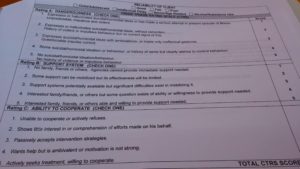Table of Contents
Introduction
The Crisis Triage Rating Scale (CTRS; Bengelsdorf, et. al. 1984) is a telephone triage tool that can be used for determining whether an individual in crisis requires psychiatric assessment. Turner & Turner (1991) determined that a cut-off score of 9 or lower necessitated admission. This was confirmed in a follow up study by Adeosun et. al. (2013)
The CTRS has three subscales:
- Dangerousness
- Support System
- Ability to Cooperate
Scoring
Each category is rated from 1-3, so the entire scale is scored from 3-15 (with a lower score representing less functioning.) This copy of the CTRS from the Human Services and Justice Coordinating Committee lists the response guidelines:
| Score | Urgency of Response | CTRS Rating |
|---|---|---|
| Extreme/Severe 3-9 | Immediate response recommended | A. Dangerousness _____ |
| High 10 | See within 2 hours | B. Support System _____ |
| Medium 11 | See within 12 hours | C. Ability to Cooperate _____ |
| Low 12-13 | See within 48 hours | Total Score: _______ |
| Non-Urgent 14-15 | See within 2 weeks |
Community Use and Validation of the CTRS
The CTRS has been used in community organizations that have mobile crisis teams, for the purpose of assessing whether callers require inpatient admission to a hospital. This can help guide the often murky process of crisis assessment.
Bonynge & Thurber (2008) determined that the CTRS was accurate in determining the difference between inpatient and outpatient treatment but that with all the tools tested (the Crisis Triage Rating Scale, the Triage Assessment Form and the Suicide Assessment Checklist), the determination of exactly what inpatient treatment (Hospitalization in a psychiatric or substance abuse settings, partial hospitalization or crisis beds) is most effective.
Limitations of the Crisis Triage Rating Scale
Molina-Lopz et. al. (2016) note that the CTRS “requires knowledge of each patient’s social and family support system at the time of assessment, which can be especially difficult to gauge in aggressive, agitated, suspicious, isolated or non-cooperative patients” which is a reasonable criticism of the Support System subscale of the tool.
The criteria used for the Dangerousness subscale is also interesting, for each rating there are 3-4 criteria given. Because of the difficulty in evaluating these (e.g. “Expresses suicidal/homicidal ideas with ambivalence, or made only ineffectual gestures. Questionable impulse control”) the reliability of the CTRS may be suspect.
Download CTRS
The CTRS can be downloaded from the Human Services and Justice Coordinating Committee here.
Bibliography
Adeosun, I., Adegbohun, A., Jeje, O., & Omoniyi, O. (2013). 1364 – Predictive validity of the crisis triage rating scale in the disposition of patients attending a nigerian psychiatric emergency unit. European Psychiatry, 281. doi:10.1016/S0924-9338(13)76409-5
Bengelsdorf, H., Levy, L., Emerson, R., & Barile, F. (1984). A crisis triage rating scale: Brief dispositional assessment of patients at risk for hospitalization. Journal Of Nervous And Mental Disease, 172(7), 424-430.
Bonynge & Thurber (2008). Development of Clinical Ratings for Crisis Assessment In Community Mental Health. Brief Treatment and Crisis Intervention. 8(4):304-312; doi:10.1093/brief-treatment/mhn017
Molina-López, A., Cruz-Islas, J. B., Palma-Cortés, M., Guizar-Sánchez, D. P., Garfias-Rau, C. Y., Ontiveros-Uribe, M. P., & Fresán-Orellana, A. (2016). Validity and reliability of a novel Color-Risk Psychiatric Triage in a psychiatric emergency department.BMC Psychiatry, 161-11. doi:10.1186/s12888-016-0727-7
Turner, P.M., Turner, T.J. (1991). Validation of the crisis triage rating scale for psychiatric emergencies. Canadian Journal of Psychiatry. 36(9):651-4
dead link for the “Download CTRS
The CTRS can be downloaded from the Human Services and Justice Coordinating Committee here.”
Hi Thomas,
See page 11 of this PDF for a version of the CTRS: https://wacountry.health.wa.gov.au/~/media/WACHS/Documents/About-us/Policies/Mental-Health-Triage-and-Short-Term-Treatment-Procedure—Goldfields-Mental-Health-Service.pdf?thn=0
Edit: Or page 251 of this disaster mental health manual: https://www.health.nsw.gov.au/emergency_preparedness/mental/Documents/disaster-mental-health-manual.pdf
Dustin